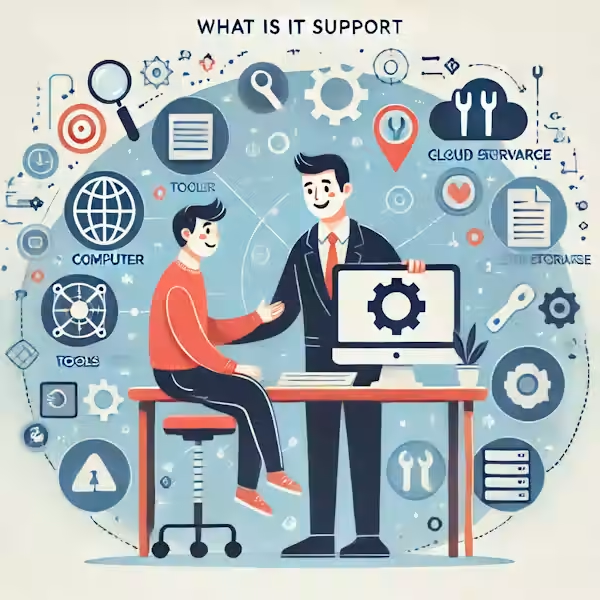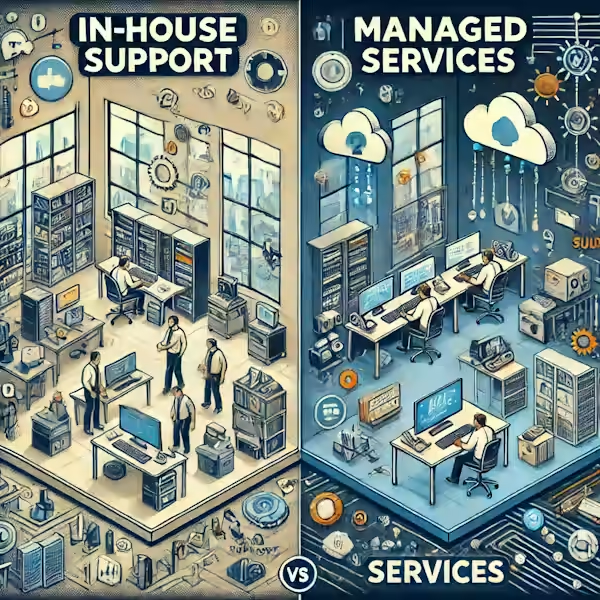Understanding IT Support for Businesses
What Is IT Support?
In other words, IT support refers to assisting different organizations in the administration, maintenance, and problems solving of the applied technologies. This includes several operational purposes that are created in order to support the effective functioning.
In other words this support is the vital core of the modern business processes.
Core Functions of IT Support
The primary functions of IT support include:
System Maintenance: Updates can be weekly, daily, or as needed so that hardware and software are running their optimum and any problems are unlikely to happen.
Troubleshooting: Eradicating technical problems in the shortest time possible is necessary to reduce the time the machines idle. Also, troubleshooting contributes to not having issues in future.
Network Management: It is the responsibility of the manager to ensure he/she supervises the workings and security of the network so as prevent possible problem. In so doing, an efficient network impacts positively on production as a testimony that organization productivity improves with network management.
User Assistance: Promoting the use of technology instruments in encouraging the employees is essential. Therefore, this support enables staff to competently undertake their activities.
These functions necessarily require input from IT support to avoid interruption of business and inefficiency.
Roles and Responsibilities of IT Technicians
A tech technician is important in the management of a firm’s technological needs. Their responsibilities include:
Addressing User Queries: Helping co-workers with their basic problems facilitate business operations. Moreover, it helps to create a favourable workplace.
Troubleshooting Hardware: Clearing physical device problems such as broken computers is very important in sustaining functionality. Also, performing such a procedure in time can help increase users’ satisfaction.
System Monitoring: This way, keeping the overall health of the system, technicians also keep an eye of any possible risks that may lower the efficiency. In this case, being proactive can reduce bigger problems.
Equipment Setup: Configuration of acquired hardware and software makes preparations once they are purchased. For this reason, this setup can help also to save costs for the process of employee orientation.
Finally, technicians make users carry out tasks with minimal interferences which in return increases efficiency.
Understanding the Levels of Support
The support services are tiered depending on the potential cascaded with the escalating issues. These levels include:
Level 1: The direct first line in handling simple problems; takes up more serious ones as well. For instance, ordinary activities could be password resetting activities.
Level 2: Even more specific help is given for complicated individual technical issues. In this case, technicians at this level have super ordinate knowledge of systems.
Level 3: For complex tasks, there is engineers’ help at the higher level. That is why they lay into the many of the most complex technical challenges.
All the levels are very relevant since they help in routing of problems hence enhancing their quick handling.
Benefits of Reliable IT Support
Effective IT support offers numerous advantages for businesses, including:
Reduced Downtime: Quick problem solving reduces operation disruptions enabling business organizations to continue their operations.
Enhanced Security: This preserves information because it maintains systems secure from threats. Thus it adds up trustworthiness of the organization.
Increased Productivity: Timely, accurate support ensures that an employee is not waiting on a piece of technology to work, while he or she must be performing other tasks. Also, it can result in higher levels of performance in most organizational activities.
Cost Savings: Preventative support can help to stop further damages occuring and save the money needed for restoration in the future. As a result, an organization can prioritize the provision of incentive compensation systems that incentives major strategies that support organizational goals as well as correctly identify goals and passionately allocate resources.
All these advantages tend toward stability, efficiency, and growth.
In-House Support vs. Managed Services
Unlike before, organizations are torn between outsourcing support or hiring an internal support team. Here’s a comparison of the two options:
Managed Services: Outsourcing is cost efficient because it brings outside skills into your environments without spending money on internal overhead. Furthermore, managed services provide a number of affordabilities suited to this type of requirement.
In-House Team: An internal team helps to have full control over the process and is capable to respond quickly in case you are at the site. Although, this method may well involve greater recurrent costs especially for remunerations and staff development. However, in-house teams seem to be in harmony with the business organization’s culture.
Lastly, it all comes down to budget, need and infrastructure exigency – in terms of how complex the infrastructure that would require this technology. Some of the small to medium business entities benefit from managed services, though the large entities may have in-house teams.
Common Challenges in IT Support
While support brings significant benefits, it also presents challenges. For example:
- Complex Issues: Advanced problems may require specialized skills and tools, which can strain resources. Consequently, organizations must ensure they have the right expertise on hand.
- High User Demand: Support teams can experience high demand, affecting response times and overall service quality. Therefore, efficient prioritization is crucial.
- Evolving Cyber Threats: Keeping up with cybersecurity threats can be daunting, necessitating that teams stay informed about the latest developments. In light of this, continuous training is essential.
Businesses can address these challenges by investing in training, updated tools, and outsourcing certain tasks when necessary.
Essential Tools for Effective IT Support
Specialized tools help support teams manage and monitor systems quickly and efficiently. Common tools include:
Help Desk Software: Zendesk or Freshdesk sort of help in solutions for support tickets and inquiries. That can, in turn, improve user experience.
Remote Access Tools: Then there are programs like TeamViewer that allow technicians to troubleshoot the issue remotely improving the time it takes to resolve. For this reason, they can tackle the issues without delays.
Network Monitoring Software: SolarWinds, monitoring network health and performance, can preemptively catch problems before they become out of hand. Proactive management can save cost and resources.
These do facilitate your teams work and help you solve problems faster.
The Advantages of Remote IT Support
With the rising popularity of remote work, remote assistance has turned out to be a valuable service. The key advantages include:
24/7 Availability: There is assistance 24/7. This is why businesses can run without interruption.
Cost Reduction: They can solve many issues without on site visits, eliminating travel costs and time taken to respond. Additionally, this can save you a great deal of money.
Flexibility: Remote support allows you to reach people who are skilled when you need them quickest. However, this makes the organizations agile.
By this definition, remote help is a flexible and cost effective means to provide continued technical help for businesses.
Understanding IT Support Costs
How much one will be spending on the IT support depends on the type of IT support. Here’s a breakdown:
In-House Team: Some of the main costs you will incur when using an internal team include Employee remuneration, employee perks, training the employees among others. As a result organizations need to closely manage for these costs.
Managed Services: As a rule, the service from the third party providers is available on a monthly basis at an affordable price for most organizations. This makes it less probable to have unexpected side effects on the organization’s income arranging than it is to other choice.
Finally, the decision needs to be made on the basis if the specific needs and conditions of the organization in question.
How to Choose the Right IT Support Solution for Your Business
The best way to choose your IT support option depends on your budget, scale, and need. Here’s a quick guide:
Assess Your IT Needs: Decide what are the scale and complexity of the IT support infrastructure that is required.
Consider Your Budget: Figure out what to pay for versus hiring.
Look for Reliability: Make sure the IT support provider you have can provide service on time.
Check for Scalability: Select a solution that will grow as your business grows into the future.
If businesses consider carefully these factors, they can select a best service – cost balance solution.
FAQs on IT Support
How much does IT support cost?
Costs vary by service model; managed services often have monthly fees, while freelance support is billed hourly.
Who should support or maintain the IT infrastructure?
This depends on the size and needs of the business. Managed IT support can be ideal for small businesses, while larger companies may need in-house teams.
What is remote IT support?
Remote IT support allows technicians to resolve issues online without needing to be physically present, making it cost-effective and flexible.
Why Choose Our IT Support Services?
We know at ITech Valley that reliable IT support is absolutely critical to the operation of your business. The services we deliver are managed services, remote assistance, or on site expertise from our team of expert professional that are dedicated to provide the best support solution services for your requirements.
With our preventive approach, you can enjoy the lowered downtime, increased security and increased productivity. Select ITech Valley as your resource for the reliable business line—so you can concentrate on development and innovation. We support your IT infrastructure effectively affordably contact us today.





